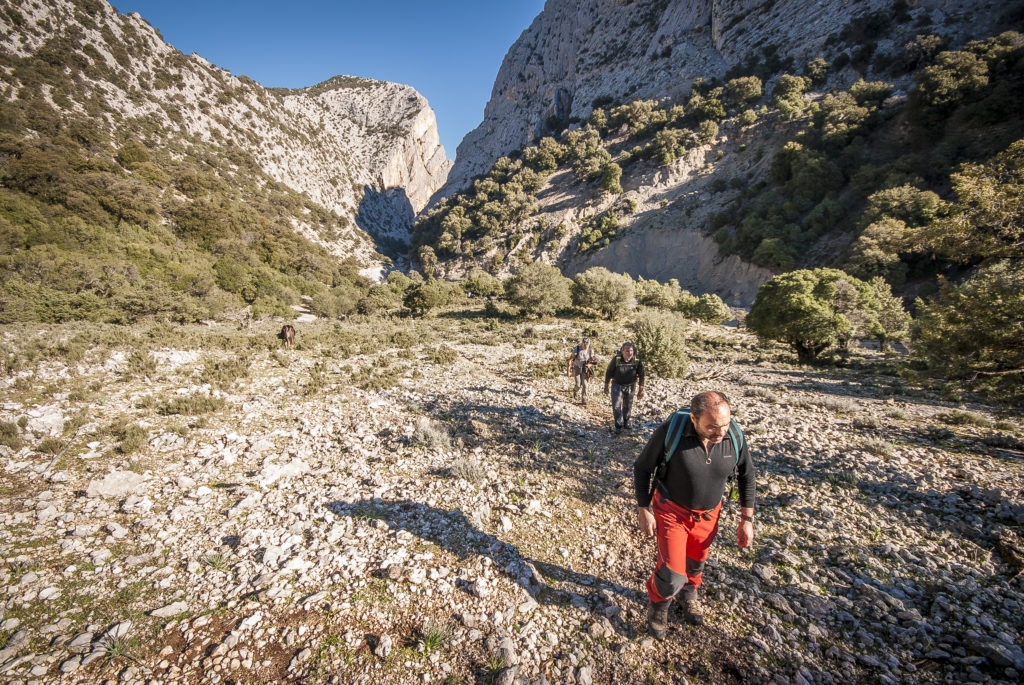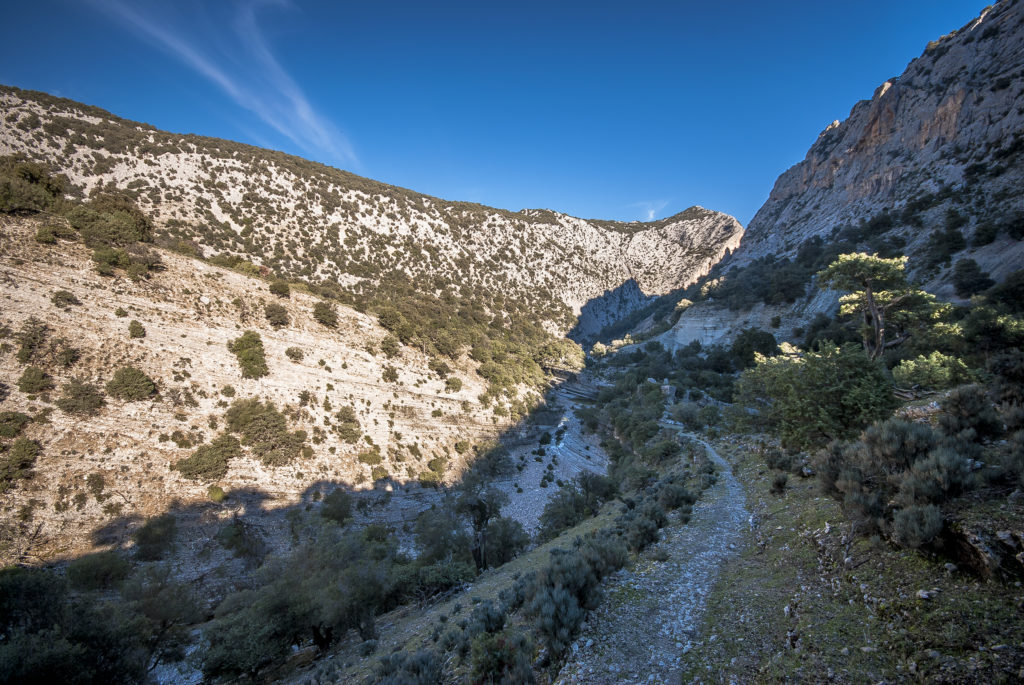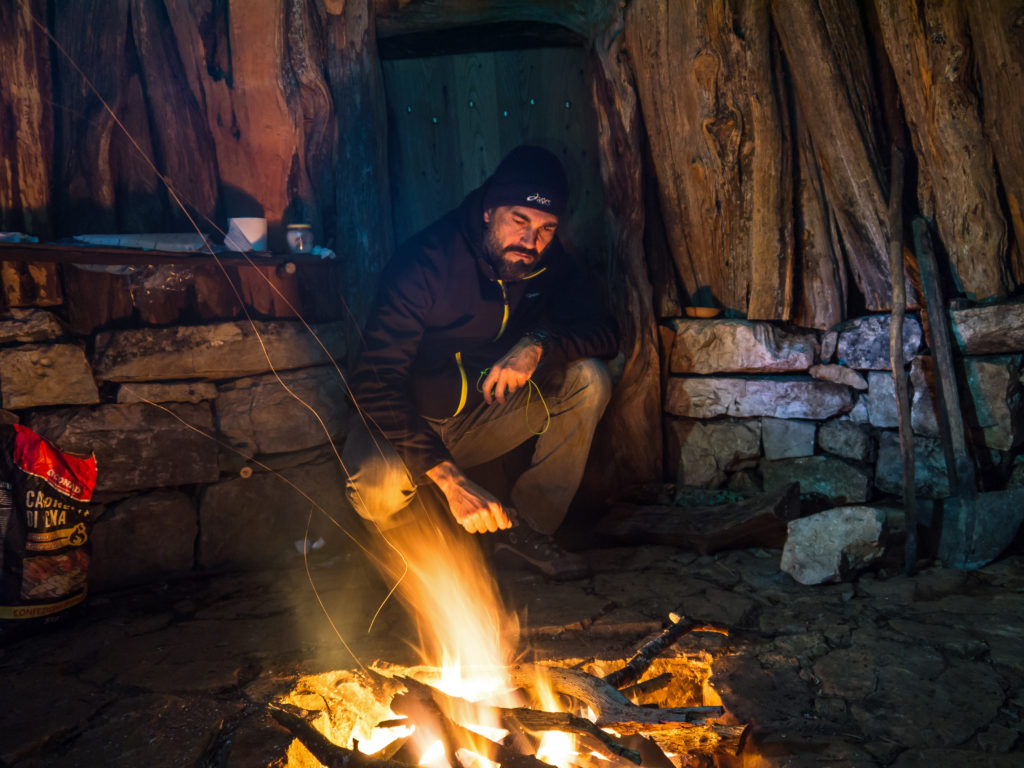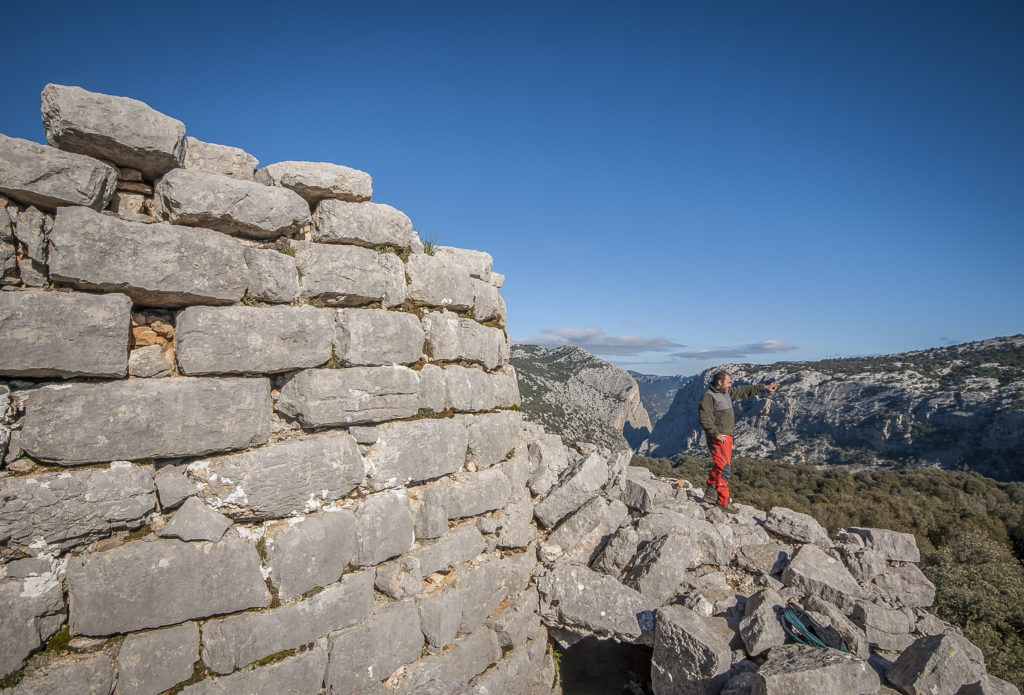Mutiamo tutti, da un giorno all’altro, per lente e inconsapevoli evoluzioni, vinti da quella legge ineluttabile del tempo che oggi finisce di cancellare ciò che ieri aveva scritto nelle misteriose tavole del cuore umano. (G. Deledda) We all change, from one day to the next, by slow and unconscious evolutions, overcome by that inevitable law of time that today ends up canceling what yesterday had written in the mysterious chambers of the human heart. (G. Deledda)
It’s still dark. I open my eyes as always just before the alarm drags me out of bed. Despite the excitement of the journey, the bitter cold of this Saturday in December seems to invite me to roll up the blankets and sink into the arms of more sleep. It’s only the desire to revisit a special district that push me into a shower in the style of a cat thrown into a water bucket. A cold and quick breakfast and I hear the sound of a little honking from the seventies. It’s my friend Peppe with his white Renault quattro that seems to come out of the French films that we watched on our old black and white Telefunken TVs. It seems like a journey from another time and I like it. The car, which seems to overturn at every bend, travels at a speed of eighty km/h and while we drive along highway 130, the view outside the windows pass by in slow motion. Grasslands after too long a drought follow one another intermingled with bare hills where some ruins testify to the abandonment of the area as a place for livelihood. Only a few flocks of sheep that begin to graze the frosty grass look at my sleepy face. But I do not want to sleep, just as I did not when my father took me to the centre of Sardinia to discover new places. The beauty of being a passenger is in this experience.
È ancora buio. Apro gli occhi come sempre prima che la sveglia mi butti giù dal letto. Nonostante l’eccitazione del viaggio, il freddo pungente di questo sabato di dicembre sembra quasi invitarmi a rimboccarmi le coperte e sprofondare nelle braccia di un Morfeo poco sportivo e camminatore. Solo il desiderio di rivedere certi luoghi mi spinge verso una doccia nella quale mi infilo e riesco, in stile gatto buttato in una bacinella. Una fredda e veloce colazione e un piccolo colpo di clacson anni settanta. È il mio amico Peppe con la sua Renault quattro bianca che sembra uscita dai film francesi che guardavamo sul nostro mitico Telefunken in bianco e nero. Sembra un viaggio d’altri tempi e la cosa mi piace. La macchina, che sembra si debba capottare ad ogni curva, viaggia ad una velocità di ottanta chilometri orari e, mentre percorriamo la statale 130, il panorama fuori dai finestrini scorre come al rallentatore. Prati verdissimi dopo una siccità troppo lunga si susseguono intervallati da colline brulle dove qualche rudere testimonia l’abbandono della terra che forniva da sempre il sostentamento primario. Solo qualche gregge che inizia a brucare l’erba zuppa di brina fa capolino al mio sguardo appannato dal sonno. Ma non voglio dormire, così come non lo facevo quando mio padre mi portava nel centro Sardegna alla scoperta di posti sempre nuovi. Il bello di fare il passeggero sta proprio in questo.

Traveling by car in Sardinia is like being in a National Geographic documentary. A fantastic dawn, colours that even in the winter are bright and saturated. My mind stirs and memories also become music. I begin to hum ‘4 March 1943’ by Lucio Dalla remembering the trips in the back seat of the legendary coffee coloured Prinz. The small towns we meet on our way are similar to those in my memories or maybe I still want to believe they are. The taste of true Sardinia, the one you do not find in cities like Iglesias or Cagliari but here, in the heart of this island. Stopping for a coffee at a bar in the countryside, maybe the only one open at this time, I am what I always wanted to be, Sardinian. To hear a language that is not Italian and trying to emulate it has always been difficult for me. With two parents, one from the mainland and the other Sardinian, it was difficult to speak Sardinian in the family. And even if my father felt Sardinian by adoption, I never felt I belonged to this island in the same way as my friends. It’s just like in an adoption, you love your parents but inside you know you’re not their natural child. And that’s why I reached for and trained my feeling of being Sardinian, getting to know my land with my father. My dad loved the Sardinians and their land and was always grateful to them for giving him a family and a home when years before he had lost a horrible war. I, on the other hand, not having deep roots like others, had to try to feel at home somewhere. And I started traveling into the centre of the island, the wild, sometimes inhospitable areas with my old friends, Peppe, Bruno and Gigi. Like today in this imitated leather seat with my friend who drives calmly through the deserted streets towards Urzulei. I watch him as he continues to talk like a cackling automatic weapon. According to him, the road he is on is the fastest, even if I do not understand what would have changed if we had come from the East. We would have traveled at 70km/h and maybe more comfortable. Of course, he is right on one account, the landscape is of an imposing beauty. We climb on a steep road that after almost an hour pans out just above the Eastern coast of the island. It is early, but from the ridges of these barren hills you can see the lights of a town that; after some bickering with my driver friend; I think is Talana. There we stop to buy freshly baked bread in a small shop. A lady in a white coat welcomes us, she has a great desire to communicate that I don’t share at this time of the morning. But, I think, it is something that I would like every time I go into one of those cold supermarkets where you shop quietly until you pay at the cashier.
Viaggiare in auto in Sardegna è come stare davanti a un documentario di National Geographic. Un albeggiare fantastico, colori che anche in inverno sono sempre brillanti e saturi mi colpiscono la mente e i ricordi diventano anche musica. Inizio a canticchiare 4 marzo 1943 di Lucio Dalla ricordando i viaggi sul sedile posteriore della mitica Prinz dal color caffellatte. I piccoli centri abitati che incontriamo sulla nostra strada sono simili a quelli dei miei ricordi o forse lo voglio ancora credere. Sanno di Sardegna vera, quella che non incontri né a Iglesias o a Cagliari ma qui, nel cuore di quest’isola. Fermarsi anche solo per un caffè al bar di un paese, magari l’unico aperto a quest’ora, mi avvicina a ciò che vorrei essere sempre stato, sardo. Sentire parlare una lingua che non è italiana e cercare di emularla per me è sempre stato difficile. Con due genitori, uno continentale e l’altra sarda, difficilmente si parlava sardo in famiglia. E anche se mio padre si sentiva sardo d’adozione, io non ho mai sentito di appartenere a quest’isola come tanti altri miei amici. Ma è proprio come in un’adozione, tu ami i tuoi genitori ma dentro di te sai che non sei il loro figlio naturale. Ed è per questo che ho raggiunto e allenato la mia sardità provando a conoscere a fondo la mia Sardegna con lui, mio padre. Amante dei sardi e della loro terra e sempre riconoscente nei loro confronti di avergli regalato una famiglia e una casa che anni prima aveva perso per una guerra bastarda. Io, d’altro canto, non avendo radici profonde come altri, dovevo provare a sentirmi a casa, da qualche parte. E ho iniziato a viaggiare in quel centro dell’isola che sa di selvaggio, a tratti inospitale e con i miei amici di sempre, Peppe, Bruno, Gigi. Come oggi in questo sedile similpelle e il mio amico che guida in modo tranquillo per le strade deserte in direzione Urzulei. Lo osservo mentre continua a parlare scoppiettante come un’arma automatica. A suo dire, il percorso che sta affrontando è il più veloce, anche se non capisco cosa sarebbe cambiato se fossimo passati dall’Orientale. Sempre a settanta all’ora avremmo viaggiato e forse anche più comodi. Certo, in una cosa ha ragione, i paesaggi sono di una bellezza imponente. Ci inerpichiamo su una strada ripidissima che dopo quasi un’ora spunta proprio sopra la costa orientale dell’isola. È presto, e dai costoni di queste brulle colline si intravedono le luci di un paese che dopo qualche battibecco con l’autista amico, ritengo essere Talana dove ci fermiamo per comprare il pane appena sfornato in un piccolo negozio. Ci accoglie una signora con un camice bianco e una gran voglia di comunicare che a me manca a quest’ora del mattino. Ma, penso, è qualcosa che vorrei ogni volta che entro in uno di quei freddi supermarket dove hai il tuo numerino e muto, fino a che non paghi in cassa.

We leave again for our little holiday and now the white Renault 4 performs its duty facing the first of the dirt roads to reach the area of Sedda ar baccas. This road is of an overwhelming beauty. Unique, but very similar to the scenery of the centre of Sardinia. Peaks of rocky hills alternate with dense holm oak woods. We finally arrive at our pinnetto (traditional shepherd’s hut) after having risked an accident for not having evaluated how slippery the last steep descent was. The hut is uninhabited and made available for those who want to spend one or more nights. And with this cold winter I understand even more why there is no que to sleep here. I open the door and the vapour coming out of my mouth confirm my belief that staying here tonight will be tough. But Peppe is adamant and does not want to hear about changing plans and installs himself in our little igloo. I’m sceptical to the high mountain altitude plus the humidity of the floor, but there is no use to discuss with friends who are more Sardinian than you. For them it is almost a moment of reconciliation with our land. Live at least a night or two like our ancestors did. Lighting the fire at the centre of the hut, cooking a few pieces of meat and drinking a glass of wine among friends, is part of that ritual that we call Contus de fochile. Where we are together before and after dinner, we talk about everything and nothing. So I want to oblige and this means looking for wood for the night. All while we look out over the gorge of the Orbisi river where I years before descended in a double rope. This majestic environment has always made me feel small, small and helpless in this nature as beautiful as it is inhospitable. But the need to make me embrace these conflicting feelings has always brought me back to the same old places. A whistle and a shout tell us that our other two friends have also arrived at the hut. I think they have probably followed the most direct, ‘fastest’ route and therefore arrived later than us. It is sunset and the only inhabitable place in this cold winter afternoon is the pinnetto.
Ripartiamo per la nostra vacanza ed ora la Renault 4 bianca compie il suo dovere affrontando le prime sterrate per raggiungere la località di Sedda ar baccas. Il tracciato è di una bellezza travolgente. Unico ma tanto simile a tutti gli scenari di questo centro Sardegna. Picchi di colline rocciose si avvicendano a boschi di leccio fittissimi. Arriviamo finalmente al nostro pinnetto non prima di aver rischiato un incidente per non aver valutato quanto fosse scivolosa l’ultima ripida discesa. Il rifugio è disabitato e reso disponibile per chi voglia farci una o più notti. E in questo inverno capisco ancor di più perché non ci sia la fila per dormire qui dentro. Apro la porta e il vapore acqueo che esce dalla mia bocca rafforza la mia convinzione che pernottare qui stanotte sarà veramente dura. Ma Peppe è intransigente e non vuole sentirne a cambiare programmi e montare la nostra piccola igloo. L’altitudine dove è ubicato l’ovile e l’umidità del pavimento non mi piace ma c’è poco da discutere con amici che sono più sardi di te. Per loro è un momento quasi di riconciliazione con la nostra terra. Vivere almeno una notte o due come lo hanno fatto i nostri antenati. Accendere il fuoco al centro, cucinare qualche pezzo di carne e bere un bicchiere di vino tra amici, fa parte di quel rito che noi chiamiamo Contus de fochile, dove si sta insieme il prima e il dopo cena, si parla di tutto ma soprattutto di nulla. Quindi voglio accontentarlo e questo vuol dire ricerca di legna per la notte mentre ci affacciamo sulla gola del rio Orbisi che anni prima avevo disceso in corda doppia. La maestosità di questo ambiente mi ha sempre fatto sentire piccolo piccolo, omino indifeso in questa natura tanto bella quanto inospitale. Ma il bisogno di farmi abbracciare da questi sentimenti contrastanti mi ha sempre riportato negli stessi vecchi luoghi. Un fischio e un urlo ci indicano che anche gli altri due amici sono arrivati al rifugio. Probabilmente avranno seguito la strada più diretta, più veloce e si saranno alzati più tardi di noi, penso. È il tramonto e l’unico luogo vivibile in questo freddo pomeriggio invernale è proprio il pinnetto.

The fire begins to warm up the surroundings and the spirit. The glasses are full and everyone is in a good mood. We remember the good times, as if today we were poorly. The fantastic nineties, the independence, and all the fault of the Euro. The discussions start from global contexts but they always end up talking about someone. On what purpose somebody did something or if they will be married. But we all agree on one thing. Do not burn the meat and do not go home with a full bottle. It will seem like something that happens once in a blue moon, but these discussions are a real must-have that recurs every weekend we are in front of a fire. The night brings a deep and regenerative sleep for some. It is a night in which there will be loud snoring, like a boar looking for nuts. Those annoyed by the snoring will, with unlikely success, try to awaken the snorer with a clap of hands that will only keep himself awake. There are complaints from those who have not brought the mattress because it was too fashionable and who is too cold to go out to do a wee and therefore does not sleep at all. Some will rest and some will remain sleepless, surrounded by the night of the Supramonte, waiting for the light of the sun to appear between the open spaces of the roof of our hut.
Il fuoco inizia a scaldare l’ambiente e gli animi. I bicchieri sono pieni e l’umore di tutti è alle stelle. Si ricordano i bei tempi, come se oggi stessimo male. I mitici anni novanta, l’indipendentismo ed è tutta colpa dell’Euro. Le digressioni iniziano da contesti globali ma finiscono sempre con il nominare qualcuno. O sul che fine avrà fatto o se si sarà sposato. Ma su una cosa rimaniamo sempre d’accordo. Non far bruciare la carne e non tornare a casa con la bottiglia piena. Sembrerà una cosa che capita una volta ogni morte di Papa ma queste discussioni sono un vero must che ricorre ogni nostro weekend davanti ad un fuoco. La notte avvicina i commensali al sonno sacro, quello pesante e rigenerante. Ed è una notte in cui ci sarà chi russa rumorosamente come un cinghiale in cerca di ghiande al quale farà eco quello infastidito che, con un improbabile successo, tenterà di risvegliarlo con un battito di mani che avrà solo il risultato di tenere sveglio solo lui. Lamenti di chi non avrà portato il materassino perché faceva troppo fashion e chi avrà troppo freddo per uscire a fare una pisciatina che non fa dormire. Chi avrà riposato e chi rimarrà insonne, avvolti dalla notte del Supramonte aspettando la luce del sole tra gli spazi mai chiusi del tetto del nostro rifugio.

Ovile Sedda ar Baccas – Nuraghe Mereu
After leaving the pinnetto, we descend towards the North on an accessible dirt road where you can admire famous and beautiful specimens of taxus baccata (European yew). If you continue you will arrive at ‘the tomb of the giants’ of sa Carcara, a testimony of the presence of man in this area since ancient times. Once you leave the dirt road you will begin to follow the track that leads to a steep descent on Schinale ‘e s’Arraiga, a rocky ridge that divides the Orbisi river from Flumineddu. Once we reach the bottom of the valley we will again meet Sa Giuntura where the three rivers, Orbisi, Flumineddu and Titione merge into a spectacular rock amphitheater. From here, once you have crossed the river, you go up in a South-West direction, on a track marked by stone men, towards the Nuraghe Gorropu and the Nuraghe Mereu.
Distance: approx. 9km
I recommend bringing at least two litres of water and light food. Good boots are useful when facing the slippery rocks near Sa Giuntura. The route is not difficult, but caution is always recommended because of the path will always be quite rocky and almost never even.
Lasciato il pinnetto si discende verso nord su una facile sterrata dove si potrà ammirare il famoso e bellissimo esemplare di taxus baccata il più maestoso e monumentale dei tassi presenti. Continuando si arriverà alla tomba dei giganti di sa Carcara testimonianza della presenza dell’uomo in quest’area da tempi remoti. Una volta lasciata la sterrata si inizierà a seguire il sentiero che in ripida discesa conduce a su Schinale ‘e s’Arraiga, cresta rocciosa che divide il rio Orbisi dal Flumineddu. Una volta giunti in fondo alla valle ci ritroveremo in località sa Giuntura dove i tre fiumi, Orbisi, Flumineddu e Titione confluiscono in un anfiteatro spettacolare di rocce. Da qui, una volta guadato il fiume si risale in direzione sud ovest, su un percorso segnalato da omini di pietra, verso il Nuraghe Gorropu e il Nuraghe Mereu.
Km. Tot: ca. 9
Consiglio di portare almeno due litri d’acqua, cibo leggero e buoni scarponi che diverranno utili nel momento in cui si affrontano le rocce scivolose vicino a sa Giuntura. Il percorso non è difficile ma si raccomanda sempre prudenza a causa del fondo su cui andremo a camminare sempre abbastanza roccioso e quasi mai in piano.